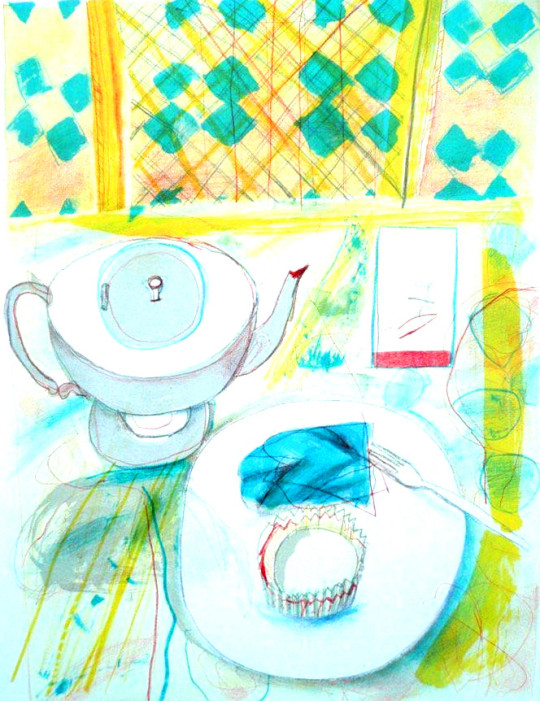
Chloë Cheese – Tea and Cake (In My Collection)
This is a post about the Cambridgeshire County Council Pictures For Schools Collection. It was a brave project founded in 1947, in part as a reaction to the brutalities of the war, but also to brighten up classrooms and schools with modern works of art and improve the minds of young children.
I am apt to using the word utopian a lot, but personally I believe projects like these were important in rebuilding Britain after the war. Not just bringing art into the home, but taking it to the public spaces; from the windows in Coventry Cathedral to the Festival of Britain, there was a manufacturing ‘brave new world’ of Britain and they used the artists as part of the team, maybe from champions of design like Robin Darwin at the Royal College of Art and exhibitions like Britain Can Make It in 1946.
The driving force behind the Pictures for Schools project was painter and educator Nan Youngman, art adviser to Cambridgeshire’s Director of Education, Henry Morris. Youngman was a student of painting at the Slade from 1924-1927, winning a prize at the Slade in 1926. She painted still, but focused on education for most of her life.
The ideas motivating Pictures for Schools were very much of their time. During and after the Second World War, as the rebuilding of Britain was debated in both the public and political spheres, educators called for art education to be given a central position in the new school system. This received support from the Ministry of Education, as part of a project to promote British culture, improve the public’s standards of taste and create a new generation of citizens and educated consumers who were capable of exercising judgement in aesthetic matters and making informed choices and purchases.
The Pictures for Schools project came out of and alongside many other famous ‘utopian’ projects like the Contemporary Lithographs (1937-38), AIA Everyman’s Prints (1940) and the School Prints series of lithographs where major artists would be paid to design a lithograph that would be printed in thousands and then sold to schools cheaply.
Youngman was involved in the Everyman’s Prints series and it may have helped inspire the running of Pictures for Schools.
In the founding of the Pictures for Schools project, one of Youngman’s big successes was after she accompanied Morris to London in 1945 to buy a painting by L.S.Lowry from the Lefevre Gallery for 30gns for the Cambridge Schools Art Collection as part of Pictures for Schools. At the start of a recession in 2009 the Cambridge County Council sold it for £541,250 at Christie’s. The commission on that sale would have been around £125k.
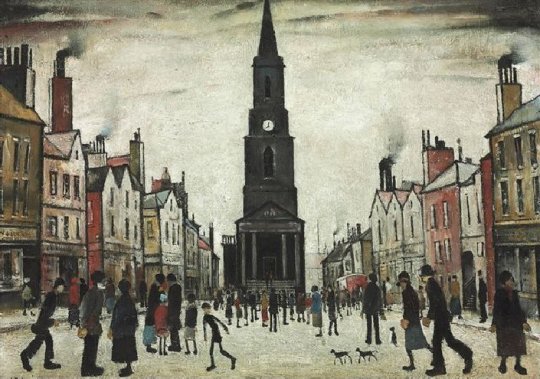
L. S. Lowry – A Market Place, Berwick-upon-Tweed, 1935
The rest of the works were due to go up for sale with Christie’s too, some of the works I own still have catalogue assignment stickers from the auction house on the back, but with the economic climate the Cambridge Council pulled the collection from auction and in 2017 they would come up again for sale with another auction house.
Although Nan Youngman was the organiser and originator of Pictures for Schools, she had the support of long-running exhibition secretaries, who themselves had interesting backgrounds and careers.
Slade-trained painter and writer Sylvia Pollak was the first Organising Secretary. She had, like Youngman and many of their circle, links with the Artists’ International Association and the Women’s International Art Club.
She was succeeded by art historian, writer and lecturer Alison Kelly, who had a particular interest in furniture and pottery, from 1950-1957, when she resigned to spend more time lecturing… During the war, Kelly had been flown around the country working on camouflage schemes for possible bombing targets such as factories.
Katharine Baker, who had been treasurer for the Society for Education through Art, took over from 1958-1967. She had previously worked for the British Institute for Adult Education, which during the war organised good design exhibitions, put pictures in air raid shelters, armed services establishments and British Restaurants, and sent exhibitions to outlying districts. She received a New Year’s day MBE in 1948 for her work on the ‘Art for the People’ travelling exhibitions.
Finally, Joan Bartlett was Organising Secretary from 1967 until after the exhibitions’ close in 1969, when the exhibitions were held at the Royal Academy’s Diploma Galleries.
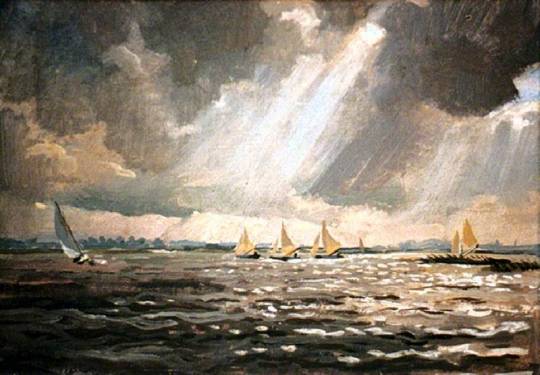
Stephen Bone – Yachts Racing at Loosdrecht, (In My Collection)
The Stephen Bone painting above was bought direct from the artist himself as on the back are various notes and bills on Bone’s headed paper.
Youngman donated some of her paintings and linocuts to the collection, other artists in the collection are like a who’s who of British Art. Gertrude Hermes, Richard Bawden, John Piper, Anthony Day, Patrick Hughes, Enid Marx, Michael Rothenstein, Malvina Cheek, Robert Tavener, Julia Ball, Peter Nuttall, Richard Beer, George Chapman, Alistair Grant, Edwin La Dell, Rosemary Ellis, Tirzah Garwood and Evelyn Dunbar are but a few.
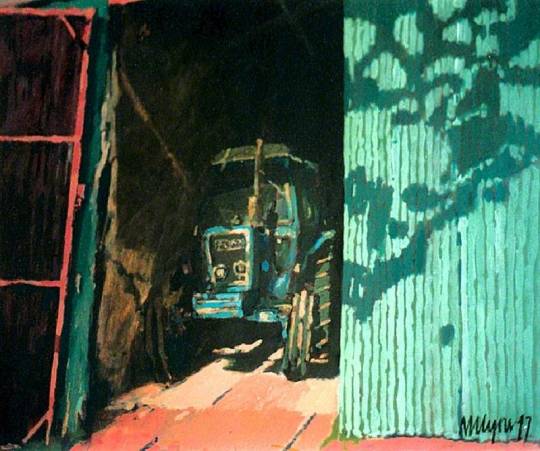
Nick Lyons – Between You and Me, 1977 (In My Collection)
As the Pictures for Schools scheme ended in the 1960s, in Cambridge the project continued under the name ‘Original Works for Children in Cambridgeshire’.
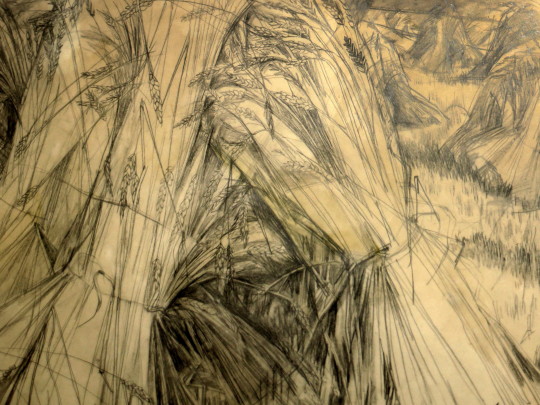
Malvina Cheek – Cornstooks at Furlongs, 1962 (In My Collection)
The Malvina Cheek drawing above came with some provenance.
I was staying at Furlongs when I drew the Corn Stooks . It was then a magical place, a shepherds cottage set in the shadow of the Downs. A gap in the wall leads up to the Downs. There was no electricity, no gas, only oil lamps and wood fires; a telephone the only concession to modern life.
In the fields alongside the cottage were pyramids of corn. The exciting shapes of the corn stooks attracted me. There was only time to draw, my daughter was very young, so I made studies hoping to develop them later. I also drew Dick Freeman, the farmer from whom Peggy leased her part of the cottage; he used an adjacent room where he rested after tending his sheep. There was always a pleasant speaking voice, a fine hooked nose and large hands like those in a Permeke drawing. Later I would use both the drawings of corn stooks and of Dick the farmer, I was commissioned to illustrate Gulliver’s Travels
Cheek also worked as part of the Recording Britain project.
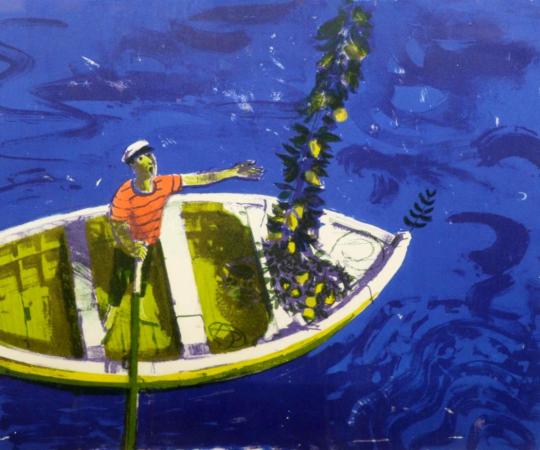
Bernard Cheese – The Lemon Seller (In My Collection)
Walter Hoyle the Great Bardfield artist took over the scheme in the 1970s. Hoyle donated a few pictures and convinced other artists to donate works to the project too. Hoyle came to be involved as he was working at the Cambridge School of Art, now part of the Anglia Ruskin University. He would teach printmaking in the St Barnabas Press, a premises that the art school rented and he would encourage his pupils to donate a print to the collection. It may also explain how a fellow Bardfield artist, Bernard Cheese gets into the collection. Hoyle retired from teaching in 1985, moving from Cambridge to Hastings and Dieppe.
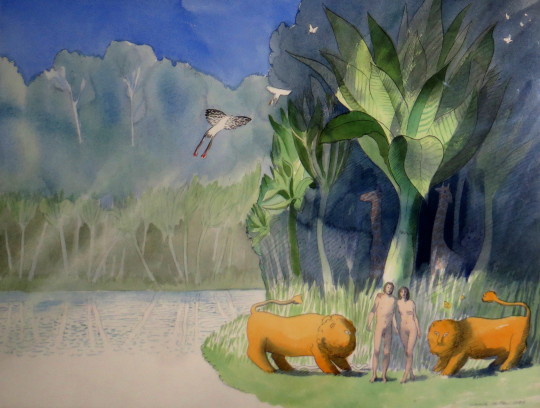
Warwick Hutton – Adam and Eve, 1986 (In My Collection)
We know the Original Works for Children in Cambridgeshire continued until 1985 when the project was run by the council and in the mid 1990s, the Council wound down the project citing the expenses of transporting the art around, hanging and administration costs and the works were stored in a shed outside Huntington Library and in a community centre in Papworth for the next 15 years.
The works by Walter Hoyle and Warwick Hutton in the collection were given with expenses for framing to the artists. Warwick Hutton’s painting of ‘Adam and Eve’ followed with a book he published in 1987 under the same name by Hutton with Atheneum Books.
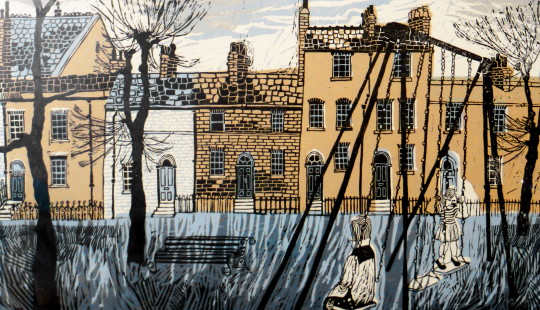
Poul Webb – Petersfield (In My Collection)
Many of the works that Hoyle encouraged his students to make were prints, Poul Webb remembered making the print above in various colourways to me when I contacted him and he now works mostly as a painter with a totally different style. The picture below by Glyn Thomas is unlike his style now too, he works in drawings and etchings but Hoyle must have been an interesting man to work under as many of the artworks have a bit of Rothenstein or Bawden in them, I guess due to the Bardfield connections.

Glyn Thomas – Corn Exchange, Cambridge, 1965 (In My Collection)
It wasn’t just Bernard Cheese and Walter Hoyle that had works in the collection from Great Bardfield. Tizah Garwood had a painting in the collection of two donkeys. Chloe Cheese also had two prints in the collection.
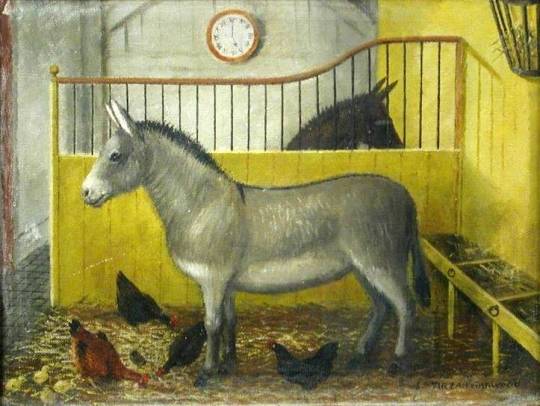
Tirzah Garwood – Nathaniel and Patsy
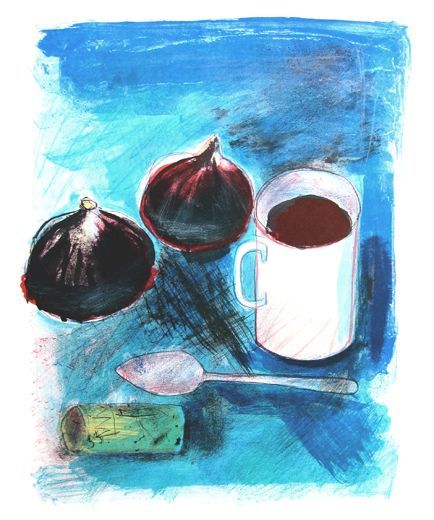
Chloë Cheese – Figs and Coffee, 1972 (In My Collection)

Norma Jameson – Black Cockerel (In My Collection)
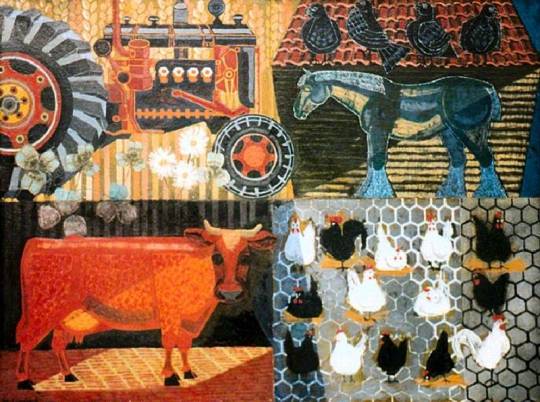
Marion Crawford – Agriculture (In My Collection)